Simplicity Coimbatore , The kadugu chutney kaddhai
Sometimes I look for info on traditional ingredients by watching tamil you tube channels. This is so informative especially when it comes to knowing more about native medicinal plants. While surfing from one video to the next I happened to chance upon one video uploaded by the channel called ‘anandha vazhviyal’. Now this particular video captured my attention because the gentleman spoke about one of my all time favourites, the kadugu chutney.
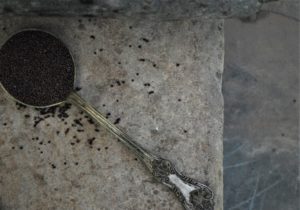
Just hearing the name brought back so many memories. The many meals that we had eaten over the years with kadugu chutney as an accompaniment is hard to count. Also the memory of the wizened elderly lady who used to make this particular chutney by hand is what got me most nostalgic.
So to give a brief introduction, Paechimma as she was fondly known was well liked by all of us. Having joined my grandmother’s household at a young age, she worked almost everyday until a few years before her last days. Her term of endearment for all of us (my siblings, cousins, friends )was the same ; “kannu”.I don’t recall her calling me by any other name. Later on we realised that her name was probably Paechi ammal which got shortened over the years.
A tall statuesque lady , she wore her saree in the pinn kosuvam style or where the pleats are tucked in at the back and left folded out . Apparently “pinkosu” is the term it is referred to.The reason I mention the manner of her saree drape was because it was an endless source of fascination for our young eyes.We couldn’t begin to fathom where the folds were secured as it was so unlike what our mothers wore.
Paechimma’s chutney making skills were legendary. My mother told us later that Paechimma would take offense if this task was given to anyone else. Highly opinionated she would boss over the others who would literally cower down to her authority. Even when I moved to my own home, she would insist on making the chutney and sending it over rather than share the recipe with me. My mother did tell me what ingredients went into it but as long as Paechimma and her affection was around,none of us ventured into making the kadugu chutney ourselves.
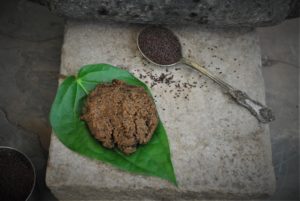
After watching the you tube video where the gentleman spoke ,adding great emphasis on the benefits of mustard seeds, thehitherto quiet kadugu chutney craving ,intensified.The recipe he read out was similar to the one made at my parents’ home. The only change I made was to add black peppercorns instead of dried red chillies.
Now this chutney is something which tastes best when ground by hand.So if you have relegated your ammi kal to the back of the store room , it’s time to get it out and give those shoulders a workout. It’s a very simple recipe as most chutney recipes are but the addition of the mustard seeds add a fantastic flavour. The secret lies in the ratio and in the way the mustard seeds are cooked.If it’s not allowed to crackle properly, the bitter aftertaste can be unpleasant.
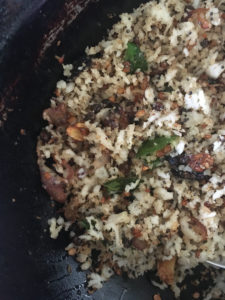
To a tablespoon of nallennai (cold pressed sesame oil) add 1 teaspoon of mustard seeds, 1 tsp of white urad dhal, few black peppercorns,6 small cloves of garlic, a handful of crushed small onions ,a small marble sized ball of tamarind,a few curry leaves and half a cup of freshly grated coconut. Once the oil is hot ,add the mustard seeds, wait for it to splutter,add the other ingredients except the coconut. Saute’ well until the onions and garlic are soft. Add the coconut ,toss it well until it is lightly toasted and take off fire. Allow the pan to cool before grinding the ingredients. It takes about 10 minutes to hand grind ,while sprinkling a little water when going back and forth.
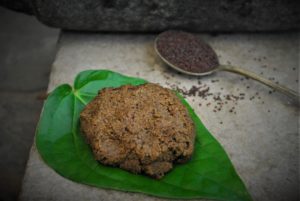
The pungency of the mustard seeds is balanced beautifully by the sweetness of the coconut.The mustard seeds take on the dominant flavour in such a manner that the onion and garlic are not prominent in any way.This chutney is a condiment which can be paired with idli /dosai /paniyaram etc and is just as delicious when eaten with lemon rice or curd rice.
There is no place which celebrates the mustard seed more than the state of West Bengal. The kasundi (mustard sauce) is practically a staple in Bengali homes. While there are variations which include the tomato,I am told that a true Bengali would turn up their nose at such inventions. I am no expert on the kasundi but it is something which I plan to try my hand at making in a few months.The end of April/May is the time of mustard harvest and this is when apparently families used to spend time washing and drying the mustard seeds before handing the harvest over to the Brahmin cooks to make the kasundi. Whether this practice still continues or not I do not know but the kasundi is made in so many variations using an assortment of spices. Green mango , vinegar, lemon juice are all used to add the sour taste.Some recipes instruct a cooking process while others only talk of fermentation. I look forward to trying them both.
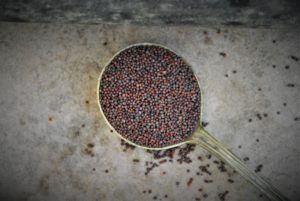
If we have failed to understand the importance of mustard seeds in our daily cooking ,it’s also due to not respecting Indian food for it’s complexities in not just taste but also nutrition. how many times have we seen people push away the mustard seeds to the far end of the banana leaf or plate ? Among many other things mustard seeds are high in Vitamin B complex ,help in regulating body metabolism and stabilizing the nervous system. They are part of the Brassica (Brassica juncea) family which also includes cabbage, brussles sprouts and broccoli.
How does that saying go ? Good things come in small packages ? Indeed they do !
Link to read more

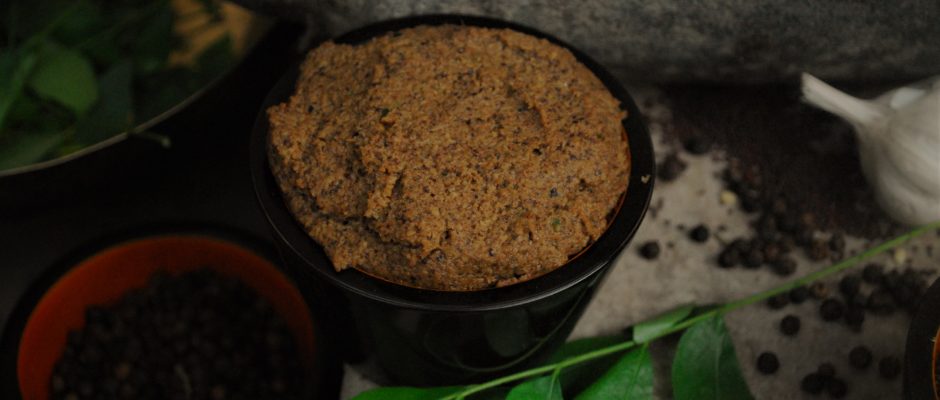
No comments yet.